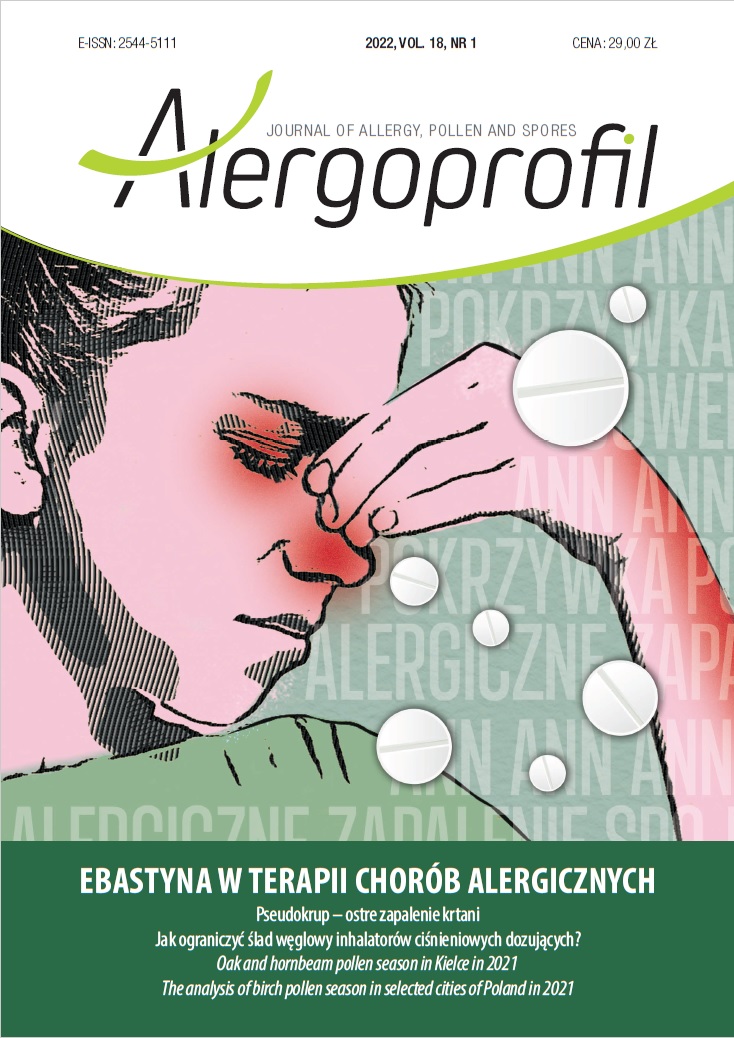Pseudo-croup – acute laryngitis Review article
Main Article Content
Abstract
Croup covers a whole group of disorders of the larynx, trachea and bronchi. It is especially dangerous for children – due to their specific anatomical and physiological conditions, which mean that the stridor can only occur when the child is crying or moving. The most common etiological factors of croup are viruses. Typical symptoms include stridor, cough (barking, seal-like), hoarseness, activation of additional respiratory muscles. The diagnosis of croup symptoms is based on physical examination and anamnesis. The aim of the procedure is to assess the severity of symptoms on the basis of the Westley scale (this is what determines further management and treatment), identifying children with a severe form of the disease and rapid progression of changes, and starting pharmacotherapy. In pharmacotherapy, glucocorticosteroids (nebulized or orally) and adrenaline (nebulized) are used. Currently, mesh inhalers, which are more efficient and convenient to use, are preferred in nebulization treatment.
Downloads
Article Details

This work is licensed under a Creative Commons Attribution-NonCommercial-NoDerivatives 4.0 International License.
Copyright: © Medical Education sp. z o.o. This is an Open Access article distributed under the terms of the Attribution-NonCommercial 4.0 International (CC BY-NC 4.0). License (https://creativecommons.org/licenses/by-nc/4.0/), allowing third parties to copy and redistribute the material in any medium or format and to remix, transform, and build upon the material, provided the original work is properly cited and states its license.
Address reprint requests to: Medical Education, Marcin Kuźma (marcin.kuzma@mededu.pl)
References
2. Sybilski AJ. Zespół krupu – aktualny stan wiedzy. Terapia. 2018; numer specjalny 8: 3-8.
3. Bjornson CL, Johnson DW. Croup. Lancet. 2008; 371: 329-39.
4. Cherry JD. Clinical practice. Croup. N Engl J Med. 2008; 358: 384-91.
5. Bjornson CL, Johnson DW. Croup in children. CMAJ. 2013; 185(15): 1317-23.
6. Ortiz-Alvarez O. Acute management of croup in the emergency department. Paediatr Child Health. 2017; 22(3): 166-73.
7. Tovar Padua LJ, Cherry JD. Croup (laryngitis, laryngotracheitis, spasmodic croup, laryngotracheobronchitis, bacterial tracheitis, and laryngotracheobronchopneumonitis) and epiglottitis (supraglottitis). In: Cherry JD, Harrison GJ, Kaplan SL et al (ed). Feigin and Cherry’s Textbook of Pediatric Infectious Diseases. 8th ed. Elsevier, Philadelphia 2019: 175-90.
8. Mazurek H, Bręborowicz A, Doniec Z et al. Acute subglottic laryngitis. Etiology, epidemiology, pathogenesis and clinical picture. Adv Respir Med. 2019; 87: 308-16.
9. Westley CR, Cotton EK, Brooks JG. Nebulized racemic epinephrine by IPPB for the treatment of croup: a double-blind study. Am J Dis Child. 1978; 132: 484-7.
10. Gates A, Johnson DW, Klassen TP. Glucocorticoids for Croup in Children. JAMA Pediatr. 2019; 173(6): 595-6.
11. Moraa I, Sturman N, McGuire TM et al. Heliox for croup in children. Cochrane Database Syst Rev. 2021; 8(8): CD006822.
12. Emeryk A, Pirożyński M. Nebulizacja: czym, jak, dla kogo, kiedy? Polski Konsensus Nebulizacyjny. Medycyna Praktyczna – Pneumonologia. 2013; 1(wyd. specjalne): 1-12.
13. Sybilski AJ. Dekalog nebulizacji. Pediatr Med Rodz. 2019; 15(2): 116-9.
14. Sosnowski TR, Odziomek M. Steroidy wziewne podawane z nebulizatorów siateczkowych – co powinniśmy wiedzieć? Terapia. 2019; 4(375): 83-8.

